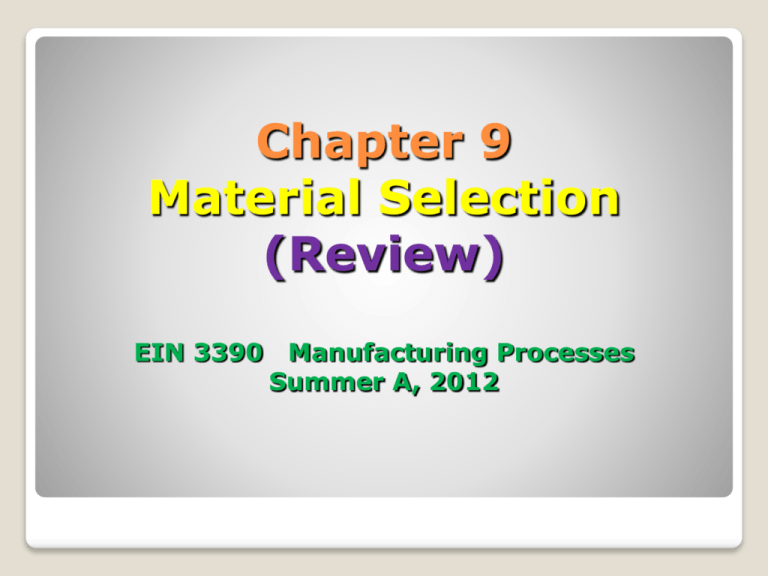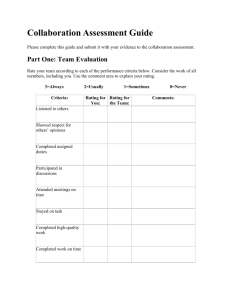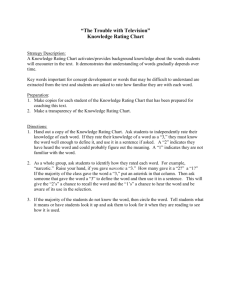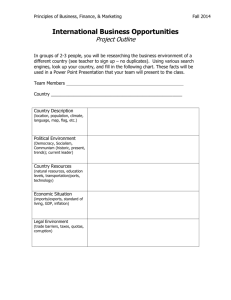Selling an Idea or a Product
advertisement

Chapter 9 Material Selection (Review) EIN 3390 Manufacturing Processes Summer A, 2012 9.1 Introduction Goal of manufacturing: to create products and components that perform properly Material selection processes should be constantly reevaluated Materials selection concerns are always changing ◦ Environmental pollution ◦ Recycling ◦ Energy ◦ Health or safety constraints ◦ Geopolitical issues 9.2 Material Selection and Manufacturing Processes Material and manufacturing processes are extremely interdependent Change in a material will likely cause a change in the manufacturing process needed A successful product has gone through both proper material selection and processing selection Figure 9-4 Schematic showing the interrelation among material, properties, processing, and performance. 9.2 Material Selection and Manufacturing Processes Material and manufacturing processes are extremely interdependent Change in a material will likely cause a change in the manufacturing process needed A successful product has gone through both proper material selection and processing selection Figure 9-4 Schematic showing the interrelation among material, properties, processing, and performance. 9.3 The Design Process Design is the first stage in manufacturing processes ◦ ◦ ◦ ◦ ◦ ◦ What it is What properties must it possess What material How to make it How many to make What conditions will it see during use Steps for Design 1. Conceptual ◦ Several concepts may be considered 2. Functional ◦ Workable designs are developed ◦ Detailed plan for manufacturing ◦ Prototyping 3. Production ◦ Full production ◦ Production speeds and quantities 9.4 Procedures for Material Selection General sequence of product design ◦ design→material selection→process selection→production→evaluation→redesign Case-history method ◦ Evaluates what has been done in the past Modification of an existing product ◦ Evaluates the current product and manufacturing techniques ◦ Changes or improves upon features of the existing product Development of a new product ◦ Follows the full sequence of product design above Factors for Materials Selections Geometric Mechanical Properties Physical Properties (Electrical, Magnetic, Thermal, and Optical) Environmental Considerations Manufacturing Concerns ◦ ◦ ◦ ◦ ◦ ◦ ◦ ◦ Quantity Rate, Level of quality Quality control and inspection Assembly concerns Section thickness Standard sizes and shapes Liability if product failure occurs End-of-use disposal 9.5 Additional Factors to Consider Cost is often one of the biggest additional factors ◦ Often, compromises between material properties and cost must be made Material availability Are there any possible misuses on the part of the consumer? Have there been failures for similar products? Material’s usage history Material standardization 9.6 Consideration of the Manufacturing Process Overall attractiveness ◦ Physical properties ◦ Mechanical properties ◦ Formability Economical concerns All processes are not compatible with all materials 9.7 Ultimate Objective Develop a combination of material and processes that is the best solution Material or manufacturing selection normally imposes restrictions or limitations on the other Economics, environment, energy, efficiency, recycling, inspection, and serviceability are important deciding factors Decision Models Figure 9-5 Sequential flow chart showing activities leading to the production of a part or product. Figure 9-6 Alternative flow chart showing parallel selection of material and process. Decision Models Figure 9-5 Sequential flow chart showing activities leading to the production of a part or product. Figure 9-6 Alternative flow chart showing parallel selection of material and process. Compatibility Figure 9-7 Compatibility chart of materials and processes. Selection of a material may restrict possible processes. Selection of a process may restrict possible materials. Material Substitutions Material Substitutions Causes of product failure ◦ Failure to know and use the best materials information ◦ Failure to account for all reasonable material uses ◦ Use of materials with insufficient data ◦ Inadequate quality control ◦ Material selection made by unqualified people Select a Material with Rating Chart 1. 2. 3. 4. 5. 6. List all required material properties for a product to be designed. Screen all required properties and identify those absolute properties that must be considered for the product as “Go-No-Go” properties. Rate each candidate material on a scale such as 1 to 5 or 1 to 10 for each required property. Define weighted factor for each required property based on its significance. Multiply property rating by its weighted factor and sum the results for each materials Select the material that satisfies the “Go-No-Go” screen and has the highest sum of the relative rating numbers. Select a Material with Rating Chart Material Go-No-Go Weldability Relative rating number - R (=rating number x weighting factor) Stiffness Stability Fatigue Tensile 1 4 5 4 SR Sr 14 A 14 B 14 C 14 SR/r Select a Material with Rating Chart Advantages: Potential materials can be compared in a uniform, unbiased manner The best candidate can often be selected There is less chance to overlook a major requirement by placing all the requirement on a single sheet. Example: Selection of a Material: Solution: • Finding “Go-No-Go” property: weldability • • • - S: satisfactory - U: unsatisfactory Calculating: R = Relative rating number, and r = weighting factor. Relative rating number R = property rating number x weighting factor • • Set material’s property rating number (1 – 5): excellent = 5, very good = 4, good = 3, fair = 2, poor = 1 weighted factor for each material’s property: • • • • - Stiffness : Stability: Fatigue: Tensile strength: 1 4 5 4 Solution (cont.) Rating chart for selecting material Weldability Stiffness Stability Fatigue Tensile Strength SR Sr SR/Sr (1) (4) (5) (4) X Go-No-Go screening S 3x1 3x4 2x5 3x4 37 14 2.64 Y U 3x1 5x4 3x5 5x4 58 14 4.14 Z S 3x1 3x4 5x5 2x4 48 14 3.43 Conclusion: Based on the chart below, material Y has the highest rating number. However, because it does not have satisfactory weldability and this is an "absolute" requirement, it should not be selected. Material Z should be used.




